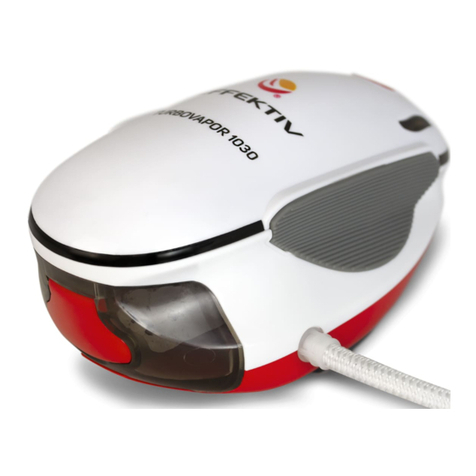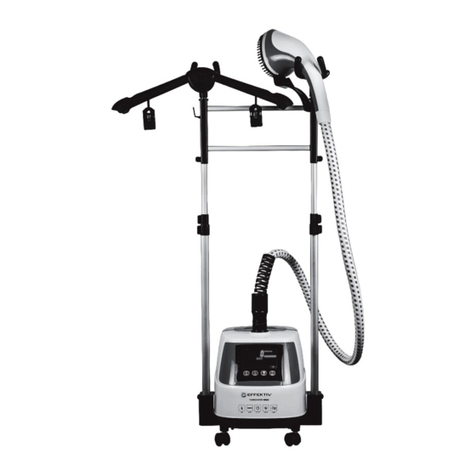EFFEKTIV TRIUMPHATOR 1700X User manual

DOMESTIC OVERLOCK MACHINE
EN USER MANUAL RU РУКОВОДСТВО ПОЛЬЗОВАТЕЛЯ
ES MANUAL DE USUARIO FR MANUEL DE L’UTILISATEUR
DE BENUTZERHANDBUCH IT MANUALE D’USO
TRIUMPHATOR 1700X / 1800X

32
TRIUMPHATOR 1700X / 1800X
RU FR
CONTENTS
1. Principal parts (names) .......................................6
2. Accessories that come with the overlock ........8
3. Needle .....................................................................9
4. How to remove the frontal lid .............................9
5. Beginning to sew ................................................10
6. Foot pedal ............................................................10
7. Using the free arm. .............................................11
8. Stitch length regulator.........................................11
9. Stitch width regulator .........................................11
10. Differential feed .................................................13
11. Assembling the thread stand…………...............15
12. Thread spool conservers ................................15
13. Spool of thread net......................................... 15
14. Thread tension release button..................... 16
15. Threading the upper looper.......................... 16
16. Threading the lower looper........................... 17
17. Using the automatic lower looper threading
mechanism...................................................... 17
18. Threading the left needle .............................. 18
19. Threading the right needle............................ 19
20. Chart with combinations of fabrics, threads
and needles ..................................................... 20
21. Thread tension adjustment.......................... 21
22. Tension adjustment chart (two-needle
overlocks)......................................................... 22
23. Beginning to sew ........................................... 23
24. Chain stitching ................................................ 24
25. Thread breakage during sewing.................. 24
26. Adjusting the pressure of the presser foot on
the fabric .......................................................... 25
27. Malfunctions and troubleshooting.............. 26
28. Rolled and narrow hem................................. 27
29. Rolled and narrow hem sample chart........ 29
30. Using different presser feet.......................... 30
31. Removing the upper knife............................. 32
32. Switching the kinfe......................................... 32
32. Convert upper looper to 2 thread serging...33
33. Cleaning and lubrication ............................... 34
34. Changing the backlight lamp ....................... 35
35. Machinespecications ................................. 36
ОГЛАВЛЕНИЕ
1. Наименованиеосновныхчастей ............ 40
2. Аксессуары,поставляемыевкомплектес
оверлоком ...................................................... 42
3. Игла .................................................................. 43
4. Какснятьпереднююкрышку.................. 43
5. Началошитья................................................ 44
6. Ножнаяпедаль.............................................. 44
7. Использованиерукавнойплатформы...45
8. Регулировкадлиныстежка....................... 45
9. Регулировкадлиныстрочки..................... 45
10. Дифференциальнаяподачаткани ........ 46
11. Установкастойкинитенаправителя.......49
12. Ограничителидлякатушкиниток .......... 49
13. Сеткадлякатушкиниток .......................... 49
14. Кнопкаослаблениянатяжениянити...... 50
15. Заправкаверхнегопетлителя.................. 50
16. Заправканижнегопетлителя................... 51
17. Использованиемеханизмаавтоматиче-
скойзаправкинитинижнегопетлителя.....
.............................................................................51
18. Заправкалевойиглы.................................. 52
19. Заправкаправойиглы................................ 53
20. Таблицакомбинацийтканей,нитейиигл...
.............................................................................54
21. Регулировканапряжениянити ................ 55
22. Таблицарегулировкинатяжения(двухи-
гольныеоверлоки)....................................... 55
23. Пробноешитье.............................................. 57
24. Выполнениецепногостежка .................... 58
25. Обрывнитивпроцессешитья................. 58
26. Регулировкадавленияприжимнойлапки
наткань........................................................... 59
27. Неисправностииметодыихустранения...
.............................................................................60
28. Ролевыйиузкийподрубочныйшов....... 61
29. Использованиеразличныхприжимных
лапок ................................................................ 64
30. Снятиеверхнегоножа ................................ 66
31. Заменаножа.................................................. 66
32.Конвертерверхнегопетлителядляпрове-
дения2-ниточнойобметкиткани............67
33. Чисткаисмазка ........................................... 68
34. Заменалампыподсветки ......................... 69
35. Спецификациямашины............................ 70
EN ES
2 3
TABLA DE CONTENIDO
1. Nombre de las partes principales ............... 74
2. Accesorios suministrados en el set............ 76
3. Aguja ................................................................. 77
4. Cómo quitar la cubierta frontal ................... 77
5. Empezar a coser............................................. 78
6. Pedal ................................................................. 78
7. Usando la plataforma de mangas... ........... 79
8. Ajuste de la longitud de la puntada............. 79
9. Ajuste de la longitud de la puntada............. 79
10. Alimentación diferencial de tejidos............. 80
11. Instalación del bastidor de guía de hilo.......83
12. Guías de hilo.................................................... 83
13. Red de hilo ....................................................... 83
14. Botón de liberación de tensión del hilo ...... 84
15. Enhebrado del áncora superior.................... 84
16. Enhebrado del áncora inferior...................... 85
17. Utilizar el mecanismo automático
Enhebrado de bucle inferior...........................85
18. Enhebrado de la aguja izquierda................. 86
19. Enhebrar la aguja derecha............................ 87
20. Tabla de combinaciones de tejidos, hilos y
agujas ... ............................................................88
21. Ajuste de la tensión del hilo.......................... 89
22. Tabla de ajuste de tensión (overlock de doble
cabezal) ............................................................ 89
23. Costura de prueba.......................................... 91
24. Costura de cadena......................................... 92
25. Rotura del hilo durante el proceso de.........92
26. Regulacion de presion del prensatelas sobre
tela..................................................................... 93
27. Fallas y solución de problemas....................94
28. Costuras de dobladillo enrolladas y
estrechas.......................................................... 95
29. Utilizar diferentes tipos de prensatelas...... 98
30. Extracción de la cuchilla superior .............100
31. Reemplazo de la cuchilla............................100
32. Para convertir el corchete superior de 2
hilos..........101
33. Limpieza y lubricación.................................102
34. Sustitución de la bombilla ..........................103
35. Información técnica ....................................104
TABLA DE CONTENIDO
1. Nom des parties principales ......................108
2. Accessoires fournis avec la surjeteuse....110
3. Aiguille ............................................................111
4. Comment retirer le capot avant ................111
5. Début de la couture......................................112
6. Pédale rheostat.............................................112
7. Utilisation de la plateforme pour manche.......
...........................................................................113
8. Réglage de la longueur de point................113
9. Réglage de la largeur de point ...................113
10. Alimentation différentielle...........................114
11. Installationdel’antenneduguide-l....... .117
12. Bloque-bobines.............................................117
13. Filetdeprotectionpourbobinedel ........117
14. Molettederelachementdelatensiondul....
...........................................................................118
15. Enlageduboucleursupérieur....................118
16. Enlageduboucleurinférieur ....................119
17. Utilisation du mécanisme automatique
d’enlageduboucleurinférieur...................119
18. Enlagedel’aiguillegauche .......................120
19. Enlagedel’aiguilledroite ..........................121
20. Tableaudecomparaisondestissus,lset
aiguilles............................................................122
21. Réglagedelatensiondul.........................123
22. Tableauderéglagedelatensiondul
(surjeteuse a deux aiguilles).......................123
23. Test de couture.............................................125
24. Réalisation d’un point de chainette ..........126
25. Aucasoulelsecasseraitpendantla....126
26. Réglage de la pression du pied presseur sur
le tissu.............................................................127
27. Dysfonctionnements et moyens de.................
....................128
28. Point d’ourlet roulé / de surjet étroit.........129
29. Utilisation de différents pieds presseurs.132
30. Retrait du couteau supérieur......................134
31. Changement du couteau ............................134
32. Convertir l’enrouleur supérieur pour surjet 2
ls..........135
33. Nettoyage et graissage ...............................136
34. Changement de la lampe d’éclairage.......137
35. Caractéristiques techniques .....................138

54
TRIUMPHATOR 1700X / 1800X
IT
DE TABLA DE CONTENIDO
1. Nom des parties principales ......................142
2. Mitgeliefertes zubehör für die overlock....144
3. Nadel...............................................................145
4. Wie sie die frontabdeckung entfernen .....145
5. Beginn des nähens.......................................146
6. Fußedal...........................................................146
7. Verwendung des freiarmes... .....................147
8. Stichlänge einstellen:...................................147
9. Nahtlänge einstellen ....................................147
10. Differenzialer stofftransport.......................148
11. Einstellen der fadenführungtragstange....151
12. Stopper für die fadenrolle ...........................151
13. Gitter für fadenrolle......................................151
14. Fadenspannungs-löseknopfl......................152
15. Bestücken des oberen schleifengänge
rs.......................................................................152
16. Bestücken des unteren schleifengänge
rs.......................................................................153
17. Benutzung des automatischen
bestückungssystems des unteren
schleifenfängers ...........................................153
18. Einfädeln der linken nadel...........................154
19. Einfädeln der rechten nadel........................155
20. Tabelle der stoff-, faden- und
nadelkombinationen ....................................156
21. Einstellen der fadenspannung ...................157
22. Spannungseinstelltabelle (doppelnadel-
overlock-maschinen)...................................157
23. Versuchsnähen.............................................159
24. Nähen eines kettenstichs ...........................160
25. Fadenbruch beim nähen.............................160
26. Einstellen des andrucks der stoffstange .161
27. Störungen und fehlersuche........................162
28. Roll- und schmale saumnaht... .................163
29. Verwendung unterschiedlicher Stoffstangen
...........................................................................166
30. Entfernen des obermessers.......................168
31. Messerersatz.................................................168
32. Oberer schleifengängerkonverter für 2-faden
säumen des stoffes......................................169
33. Reinigung und schmierung ........................170
34. Auswechseln der beleuchtungslampe.....171
35. Maschinenspezikation .............................172
TABLA DE CONTENIDO
1. I nomi delle parti principale ........................176
2. Accessori in dotazione con overlock........178
3. Ago ..................................................................179
4. Come togliere il coperchio anteriore ........179
5. L’inizio di cucitura.........................................180
6. Interruttore a pedale ....................................180
7. L’uso della piattaforma.................................181
8. Regolazione della lunghezza del punto ...181
9. Regolazione della lunghezza del................181
10. Differenziale di avanzamento del tessu
to......................................................................182
11. L’installazionedibanchialguidalocon...........
...........................................................................185
12. Limitatoriperbobinedilo.........................185
13. Magliaperbobinedilo..............................185
14. Pulsante di allentamento della tension.....186
15. Ricarica superiore looper.............................186
16. Ericarica bobina inferiore ............................187
17. L’uso di un meccanismo automatico di
rifornimentolobobinainferiore................187
18. Ericarica dell’ago sinistro.............................188
19. Ricarica dell’ ago destro...............................189
20. Tabellacombinazioniditessuti,lieaghi........
...........................................................................190
21. Regolazionedellatensionedello.............191
22. Tabella di regolazione della tensione (due
aghi zig zag) ..................................................191
23. Prova cucito...................................................193
24. Rl’esecuzione di catenella...........................194
25. Rotturadellodurantelacucitura ...........194
26. Regolazione della pressione del piedino
premistoffa ....................................................195
27. Malfunzionamenti e tecniche per la loro
risoluzione......................................................196
28. Cucitura di ruolo e a taglio..........................197
29. L’utilizzo di diversi tipi di pressione Del
piedino ............................................................200
30. Rimozione del coltello superiore ...............202
31. Sostituzione del coltello ..............................202
32. Il convertitore del crochet superiore per
eseguireilsopraggittoa2li......................203
33. Puliziaelubricazione.................................204
34. Sostituzione della lampadina.....................205
35. Informazioni tecniche .................................206

USER MANUAL
7EN
EN
TRIUMPHATOR 1700X / 1800X
6
PRINCIPAL PARTS (NAMES) 1. Handwheel
2. Power/backlight switch
3. Thread quide
4. Thread guide support rod
5. Presser foot adjusting screw
6. Spool retainer
7. Spool holder
8. Thread guide lid
9. Pressure foot lifter
10. Left needle thread tension regulator
11. Right needle thread tension regulator
12. Upper looper thread tension regulator
13. Lower looper thread tension regulator
14. Needles
15. Upper knife
16. Presser foot
17. Fabric placement platform
18. Front lid
19. Stitch width regulator
20. Stitch length regulator
21. Differential feed regulator
22. Upper knife regulating knob
23. Lower looper thread guide
24. Feed dog rack gear
25. Upper looper
26. Lower looper
27. Sleeve platform
28. Microfuse
29. Sleeve platform lid
30. Instant thread tension release button

USER MANUAL
9EN
EN
TRIUMPHATOR 1700X / 1800X
8
NEEDLE
This overlock is designed to work with standard needles. Use needles type:
НАх1 (130/70SH)
SWITCHING THE NEEDLE
1. Turn the handwheel towards you to bring the needle to its highest po-
sition.
2. Loosen the needle clamp screw with the supplied hex-key.
3. Insert a new needle into the needle holder (flat side facing away from
you) as far as it will go.
4. Tighten the needle clamp screw.
HOW TO REMOVE THE FRONT LID
To remove the front lid, slide it as far to the right
as possible, as shown in g.1.
Pull the lid towards you, as shown in g. 2
ACCESSORIES THAT COME WITH THE OVERLOCK
The numbers in the illustrations correspond to the numbers of the sewing
accessories:
1. Brush
2. Screwdriver
3. Tweezers
4. Hex-key
5. Oiler
6. Nets (4)
7. Spool of thread saver (4)
8. Set of needles: Hax1.80 / 12: 2
pcs. 90/14: 2 pcs..
9. Sewing box
10. Overlock case:
Optional (is not included, sold
separately)
11. Blindstitch foot
12. Bead/sequin sewing foot
13. Stretch stitch foot
14. Bias binding foot
15. Gathering foot
This manual suits for next models
1
Table of contents
Languages:
Other EFFEKTIV Kitchen Appliance manuals




















